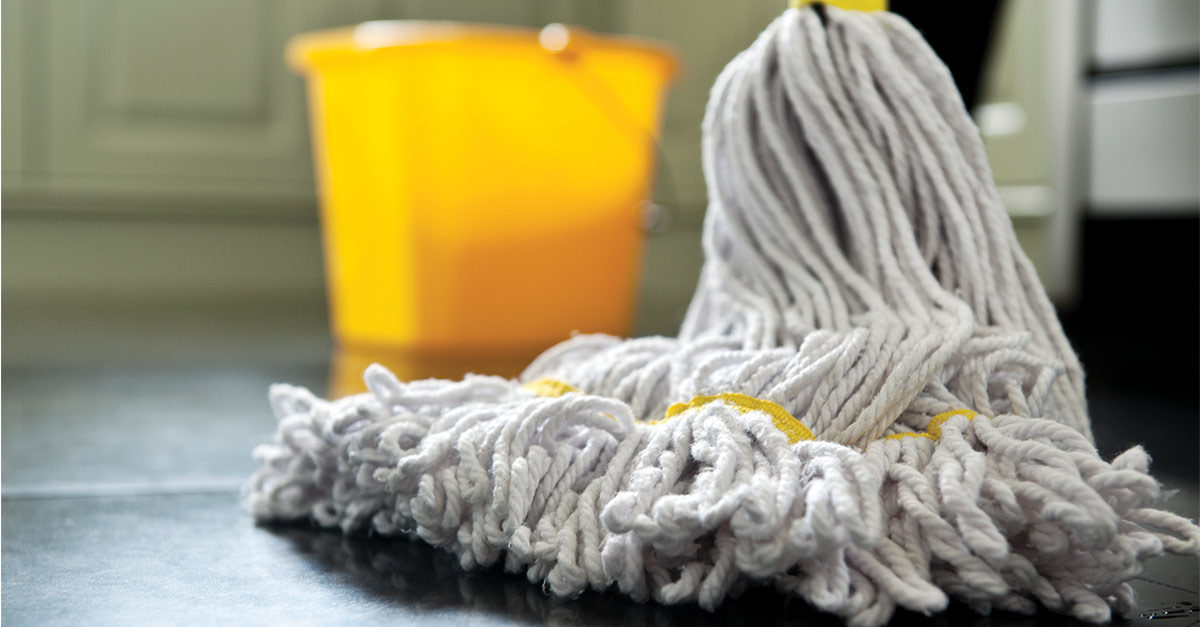We all have been faced with manually cleaning greasy, slippery tile and grout floors, whether the floor is in a quick-service restaurant, college dining hall, or an industrial facility. But do you know the key variables that cause expensive slips and falls, affect your cleaning cost and time, and impact the appearance of your floor?
To develop a solution, you need to know the causes of the problem. The process must also ensure that two dissimilar surfaces (tile and grout) are cleaned effectively but not damaged. This is very important for floors with cementitious grout. Below are the most important variables that can impact the best way to clean a greasy floor.
Tile Variations
There are many types of tiles, including unglazed quarry, high-fired ceramics, porcelain, granite, mosaic, dense stone, saltillo, and terrazzo. Seamless systems, ground-polished, and ground-polished stained concrete, all without grout lines, are becoming more prevalent. During the design process of a facility, it is vital to match the floor surface to the facility type, amount of foot traffic, and most common types of soils that need to be removed.
The surface density and texture of the tile can affect cleaning results. Adsorption is the chemical process soils use to stick to the tile surface and relates to the tile density. A highly dense tile will have less adsorption and soils won’t stick to the tile surface as easily.
Different tile surfaces have varying drying times and can also affect the coefficient of friction. (You can find the wet dynamic coefficient of friction data for tiles using the American National Standards Institute ANSI B101.3 or A326.3 standards.) Smooth tiles will dry at a slower rate than textured, unglazed tile and have a larger probability of being more slippery when wet.
The size of tiles—and the amount of grout—affects the drying time as well as the best process to use for cleaning. A smaller tile will have more grout, but will also reduce the probability of slips and falls.
Soil Variations
Soil deposits are created several ways. They can be physically carried in from outside of the facility or inside the facility between zones via foot traffic; soils such as kitchen grease and oils can originate inside the facility. Soils can also originate chemically from the saponification that occurs among certain types of cleaning chemicals, floor surface soil loads, and grout, or from the polymerization—when two or more molecules combine to create larger molecules—that can develop rapidly on tile surfaces.
Chemical Considerations
The specific chemical used on a floor affects the ease, speed, and results of the cleaning process. There are several types of floor cleaning chemicals available in the market, including basic, acid, neutral, enzyme, and biologic. Most floor cleaning chemicals suffer from two key problems: One is improper process—for example, “no-rinse” chemistry slowly building up a soil layer. The combination of chemicals, processes, and tools must be able to emulsify and degrade the soil loads without leaving chemical residue on the tile surface.
The second problem is that many chemicals offer no residual cleaning effect once the mopping process is complete. Enzyme or biologic chemicals help to reduce these problems by providing no-rinse products that break down fats, oils, and greases into “food” for bacteria in the chemical. Of course, any type of chemical you use is only effective if you and your cleaning staff use proper cleaning processes.
Wet vs. Damp
Daily floor cleaning should be done using a wet mop. The mop head should be saturated with cleaning chemical and not wrung out prior to use. Damp mopping should only be used for spot cleaning of spills or other soils as it does not deliver enough cleaning chemical to thoroughly clean the floor; buildup can quickly occur that negatively impacts the floor’s coefficient of friction, appearance, and drying time.
Move It or Lose It
Agitation is a key part of the cleaning process that is typically not done well or not done at all. Agitation is critical in ensuring the chemical can penetrate the pores of the tile surface and remain in the tile pores after each mopping. If the pores aren’t open, the chemical performance will significantly decrease. Grout also requires agitation to break down soils left behind in the grout lines during mopping.
Since mop heads alone do not provide sufficient agitation, you will need a secondary tool or process. Traditionally, for grouted tile, deck brushes with bristles are used to create required agitation. However, here too, there are issues to consider. For one, the level of abrasion required to clean the tile surface can potentially damage and wear down the grout material surfaces. The quality of deck brushes also affects the outcome: Many deck brushes have less than desirable bristle fiber-bend recovery so that, much like an overused toothbrush, the bristles soon provide very little agitation. Conversely, deck brushes with good fiber-bend recovery are more difficult to push, adding physical stress and time to employee cleaning.
Front vs. Back of House
Front-of-facility areas are where appearance and probability for slips and falls are most likely to have their greatest negative impact. There are usually no floor drains, so wet surface deck brushing is not common. Proper wet mopping process requires the chemical solution be placed onto the floor, agitated in a separate step, usually squeegeed into small areas and picked up with the mop head. Finally the area needs to be rinsed to ensure no chemical residue is left behind. This process is labor intensive and drying times are extended—but it is the proper process.
Back-of-house areas, like kitchens, typically have extreme soil loads. The choice of chemical, tools, and process quickly affects the appearance and safety of the floor. Wet mopping is mandatory in these areas as is the additional step of agitation, since improper cleaning leads to soiled-surface polymerization. And once polymerization has occurred, the agitation required to clean the surface significantly increases.
Tools
Improper floor cleaning tool selection can easily and quickly have a negative impact on cleaning results. The design and specifications of the floor mop, for example, are critical to traction, floor appearance, and floor drying time. Mop designs include cut ends, looped end, and tube mops. Materials include cotton, polyester blend, and microfiber. Specifications include the absorption and soil release rate; number of strands; strand length, diameter, and twist of yarn strands; and for microfiber tube mops, diameter and length of tubes.
While mop design is important, you will get the best result from using a mop in good condition. Newer mops and those with sustained durability will have better and faster absorption, soil release, and surface-drying properties than mops that are dirty and tattered.
Another important element of a mopping system is a double-chamber mop bucket and wringer. A double-chamber mop bucket minimizes reuse of soiled chemistry during the mopping process as the dirty chemistry is captured in a separate chamber.
If you focus on tools and processes that incorporate and ensure proper agitation, you will say farewell to greasy and slippery floors and step with confidence.


